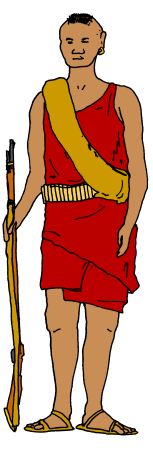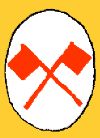|
German East Africa
African Auxiliary Personnel
 |
 |
 |
|
Figure 4
African Irregular Soldier |
Figure 2
Hospital
Askari NCO |
Figure 2
African Sailor |
|
|
 |
 |
 |
 |
 |
 |
|
Figure 1
Signals Askari |
Figure 2
Hospital
Askari NCO |
|
Figure 3
Police
Askari NCO |
Figure 4
Police
Askari |
Figure 4
African Irregular |
|
|
|
|
Figure 1 is based on a
photograph of an Schutztruppe Signals Askari. There was a separate signals detachment ("Signal-Abtleilung")
independent of the askari Field Companies in East Africa. Signallers from the
detachment were then posted to the Field Companies. As well as adults, young
cadets were recruited into the signals detachment from the best pupils from
schools set up by the Germans in East Africa. The specialist insignia of the
signals detachment was two crossed red flags in a white oval worn on the upper
left arm (see right and also the Specialist Insignia Page).
This signaller wears neither puttees nor
boots. Although the Germans took care generally to see their men
booted, askaris are also seen barefoot quite often, either due to
shortages or preference.
Schutztruppe Askari Gunners wore a
horizontal oval patch with a red bursting grenade motif in a similar
way on the upper left arm (see right and also the
Specialist Insignia Page.). During the First World
War these specialist insignia were used less and less.
|

Signals Detachment Arm Badge

Gunner Arm Badge |
|
Figure 2 is based on a
pre-war photograph of a Hospital Askari NCO. This askari attached to
hospital duties unusually wears a German hospital assistant's white tunic- of
the same cut as the Schutztruppe tunic with brass buttons and with Schutztruppe
white/red/black twisted braid shoulder straps but without the usual Schutztruppe blue
piping. On the upper left sleeve is a white circular badge bearing a medical red cross
(see the Specialist Insignia Page).
Often a simple red cross armband was worn instead. Below this is his rank insignia- two chevrons for Schausch or corporal. Both
German and African medical NCOs in East Africa wore gold chevrons on a black background (see
right). He wears a watch chain from the left breast pocket to the third tunic
button.
Aside from the tunic he is dressed
similarly to most East African askaris with the tarbush and white metal eagle,
brown belt with plain brass buckle, bayonet, khaki trousers, brown boots and
obsolete issue dark blue/grey puttees.
|

Hospital Schausch Rank Chevrons |
| Figure 5
is based on a photograph of a Polizeitruppe Askari NCO. The East African
Police ("Polizeitruppe") askaris were distinguished from Schutztruppe askaris by their larger
tarbush eagle
in brass, brass tunic buttons and an oval white
patch with the red letter P for "Polizeitruppe" on the upper left arm (see
right and also the Specialist Insignia Page). NCOs rank insignia as with all askaris
was shown with inverted red chevrons also on the left
arm. He wears one stripe denoting him as an Ombascha or Lance
Corporal (see NCO Rank Insignia Page) Figure 6 is based on a
photograph of a Polizeitruppe Askari. He wears
the red felt fez with black tassel issued to all askaris for off duty or
light duty wear instead of the tarbush. As a policeman involved in
light duties (in this photo escorting African prisoners) he only carries one
M1895 ammunition pouch for his Mauser M71 Jägerbüsche rifle.
At the outbreak of the First World War the Polizeitruppe were
incorporated into the regular Schutztruppe field companies. They were a useful
reserve to the Schutztruppe although not fully trained up to regular
askari standards. Both the arm patch and large eagle were soon
discarded in wartime. |

Police Arm Badge |
Figure 4 is based on a photograph
of an East African Irregular African Soldier taken in about 1917. Irregular
African troops (known as "Ruga-Ruga") were recruited in large numbers by
the Germans in East Africa as
guides, scouts and light infantry. They usually had no uniform at all and often wore
their traditional tribal costumes. This figure wears sandals but many were
barefoot. As with this figure most carried bandoliers
along with locally made water bottles, knapsacks and blankets. The other
figures in the original photograph are dressed equally casually, some with
non-regulation fezzes with a single feather stuck in the top. Some irregulars
were armed with Mausers but many carried
older firearms, hunting rifles, old percussion caps and spears. (On display in
the Imperial War Museum in London is an old .60 inch percussion cap musket
captured from German forces in East Africa. The musket has a very interesting
history having been sold by the United States to France after the American Civil
War, captured by the Prussians in 1870 and was still in service in the 1914-18
war.)As well as these soldiers the German forces
needed an even larger number of African Porters to carry their supplies and
equipment (not to mention dragging the SMS Königsberg's guns across many miles
and varieties of terrain during the First World War). They were usually seen
dressed lightly and poorly, in simple shirts with tied skirts or
shorts, none of which were uniform. |
| |
|